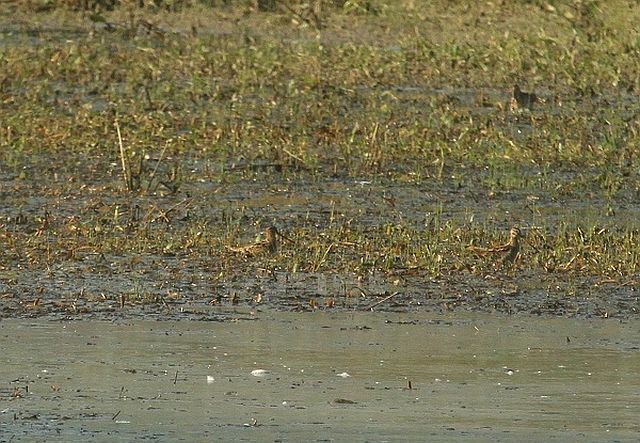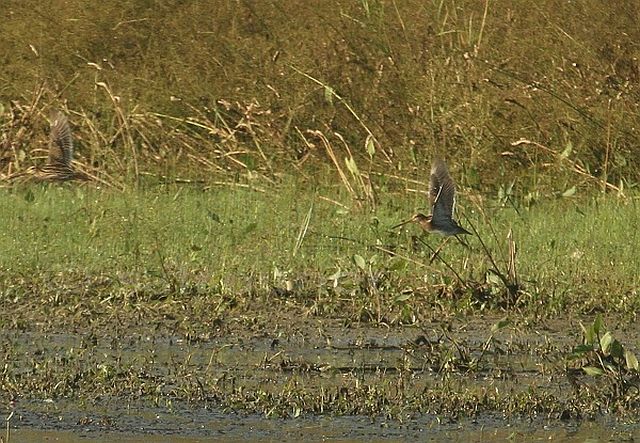285. Great Snipe Gallinago media Dubbelsnip
Order: Charadriiformes. Family: Scolopacidae
Description
26–30 cm in length and a 42–50 cm wingspan. The bulky great snipe has brown, patterned plumage, with extensive dark barring on the white underside. The wings are broad, and a pale wingbar is visible in flight. The feathers at the leading edge of the wing have bold, white tips, and the corners of the tail are also white. The long, pointed, two-toned bill has a slight droop towards the tip. They have a dark stripe through the eye.
Females are, on average, significantly larger than male great snipes, but their plumage is very similar. The only place where they do differ is in the tail, with males generally possessing longer tails with a greater amount of white.
Similar species: May be confused with African Snipe which has white on the belly, not the buffy wash overlaid with dark barring. It differs further by having a shorter bill and the white tail tip and the white outer tail feathers (those of the African Snipe are barred).
Distribution
Gallinago media breeds primarily in Russia, east to 95°E, in Belarus and Norway. It also breeds in Poland, Finland, Sweden, Estonia, Latvia, Lithuania, Ukraine and Kazakhstan.
From early August, it migrates through central Asia, central and south-eastern Europe Tunisia and Egypt, with birds gathering in wet high-plateau grasslands in Ethiopia. When these dry out in October, birds follow the rains south and west to Sudan, South Sudan, Chad, Burkina Faso, Mali, Mauritania, Senegal, Sierra Leone, Liberia, Côte d'Ivoire, Ghana, Togo, Benin, Nigeria, Cameroon, Gabon, Congo, Democratic Republic of Congo, Kenya, Uganda, Rwanda, Burundi, Tanzania, Malawi, Zambia, Zimbabwe, Mozambique, South Africa, Angola and Namibia.
Habitat
While breeding, the great snipe has fairly specific habitat requirements and requires a habitat rich in invertebrates with some scrub cover. It usually occurs in wide river valleys, meadows, peatland, tundra with scattered bushes and, less often, woodland adjacent to marshes or bogs. Outside of the breeding season, the great snipe frequents wetland areas, including marshlands and short grass or sedges on lake edges or in flooded fields. It is also found in drier habitats such as moorland, sand dunes, tracks in wooded areas, in plough furrows and occasionally at puddles on dirt roads or in old cultivation.
Movements and migrations
In early August, after the breeding season, great snipes leave their European breeding grounds and begin the impressive migration to sub-Saharan Africa. Most birds arrive in southern Africa in November, occasionally earlier in September and October, staying until March before heading back to its Eurasian breeding grounds.
Diet
In Europe it mainly eats annelid worms, insect larvae, small molluscs and crustaceans, doing most of its foraging by probing for invertebrates in soft mud, often at sports fields, marshes, plough furrows and puddles on dirt roads.
Breeding
It breeds from mid-May to early-July and nests solitarily, although it has a polygamous mating system. The female is solely responsible for building a nest, incubating the eggs and caring for the young. The nest is a shallow depression with a slight lining of grass or moss. It is situated on the ground or on grassy tussocks in swamps. It is often completely concealed in thick vegetation but may be fairly exposed. An average of four eggs are laid and incubated for 22 to 24 days. The young become independent at 21 to 28 days of age, immediately after fledging.
Call
Generally silent, but may croak when put to flight.
Status
Rare summer visitor. The Great Snipe is classified as Near Threatened (NT) on the IUCN Red List.
Africa Wild Bird Book
Great Snipe
Dewi
What is the good of having a nice house without a decent planet to put it on? (H D Thoreau)
What is the good of having a nice house without a decent planet to put it on? (H D Thoreau)
Great Snipe Photos
Dewi
What is the good of having a nice house without a decent planet to put it on? (H D Thoreau)
What is the good of having a nice house without a decent planet to put it on? (H D Thoreau)
- nan
- Posts: 26454
- Joined: Thu May 31, 2012 9:41 pm
- Country: Switzerland
- Location: Central Europe
- Contact:
African Snipe
286. African Snipe Gallinago nigripennis (Afrikaanse Snip)
Order: Charadriiformes. Family: Scolopacidae
Description
30-32 cm. Cryptic plumage with paler edges to the feathers. Brown upperparts, head and neck, streaked and patterned with bold dark brown stripes. Gold edges to the feathers form 'braces' down the back White belly, though there is some brown barring on the flanks. It shows white trailing edges on the wings and white tail corners in flight. Very long, straight pinkish-brown bill. Yellowish-olive to greenish-grey legs and feet. Sexes similar.
Immatures have pale fringes on the wing coverts.
Similar species: The long, straight bill and striped head markings distinguish this species from all except Great Snipe, from which it is differentiated by the longer bill, barred outer tail feathers.
Distribution
Occurs in patches of sub-Saharan Africa, from Ethiopia through Uganda and eastern DRC to Zambia, Angola and southern Africa. Here it is uncommon to locally common in north-eastern Namibia (including the Caprivi Strip), northern and south-eastern Botswana, central Zimbabwe, small patches of Mozambique and much of South Africa, largely excluding the Northern Cape and Limpopo Province.
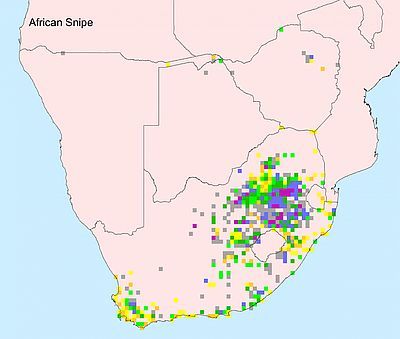
Habitat
It generally prefers freshwater and brackish wetlands, such as vleis, marshes, wet grasslands at high altitudes, margins of well-vegetated pans and riparian wetlands around artificial water bodies.
Movements and migrations
It can be sedentary, locally migratory or nomadic depending on environmental conditions, as for example it is largely absent from Zimbabwe in the period from January-April, when it probably disperses to other adjacent countries. It may also move out of an area if wetlands dry up or otherwise change for the worse.
Diet
Aquatic insects. Its diet mainly consists of annelids, insect larvae, small molluscs, crustaceans and seeds, doing most of its foraging by probing soft mud with its long bill.
Breeding
Monogamous, solitary nester, performing a strange courtship display in which it dives to the ground from a high vantage point, beating its wings against its tail feathers in such a way that it produces a drumming sound. The nest is probably built solely by the female, consisting of a saucer-shaped grass structure placed in a tuft of grass or rushes. Egg-laying season is almost year-round, peaking from March-August in Zimbabwe and July-September in the Limpopo Province and Western Cape. It lays 1-3, usually 2 eggs, which are incubated solely by the female, who is well concealed by the vegetation adjacent to the nest. The chicks are brooded by both parents, probably leaving the nest at roughly 19-20 days old and becoming fully independent soon afterwards.
Call
'Mud sucking' call tchek or ghip very characteristic. Gives impressive aerial drumming wu-wu-wu sounds. Listen to Bird Call.
Status
Common resident in suitable habitat.
Order: Charadriiformes. Family: Scolopacidae
Description
30-32 cm. Cryptic plumage with paler edges to the feathers. Brown upperparts, head and neck, streaked and patterned with bold dark brown stripes. Gold edges to the feathers form 'braces' down the back White belly, though there is some brown barring on the flanks. It shows white trailing edges on the wings and white tail corners in flight. Very long, straight pinkish-brown bill. Yellowish-olive to greenish-grey legs and feet. Sexes similar.
Immatures have pale fringes on the wing coverts.
Similar species: The long, straight bill and striped head markings distinguish this species from all except Great Snipe, from which it is differentiated by the longer bill, barred outer tail feathers.
Distribution
Occurs in patches of sub-Saharan Africa, from Ethiopia through Uganda and eastern DRC to Zambia, Angola and southern Africa. Here it is uncommon to locally common in north-eastern Namibia (including the Caprivi Strip), northern and south-eastern Botswana, central Zimbabwe, small patches of Mozambique and much of South Africa, largely excluding the Northern Cape and Limpopo Province.

Habitat
It generally prefers freshwater and brackish wetlands, such as vleis, marshes, wet grasslands at high altitudes, margins of well-vegetated pans and riparian wetlands around artificial water bodies.
Movements and migrations
It can be sedentary, locally migratory or nomadic depending on environmental conditions, as for example it is largely absent from Zimbabwe in the period from January-April, when it probably disperses to other adjacent countries. It may also move out of an area if wetlands dry up or otherwise change for the worse.
Diet
Aquatic insects. Its diet mainly consists of annelids, insect larvae, small molluscs, crustaceans and seeds, doing most of its foraging by probing soft mud with its long bill.
Breeding
Monogamous, solitary nester, performing a strange courtship display in which it dives to the ground from a high vantage point, beating its wings against its tail feathers in such a way that it produces a drumming sound. The nest is probably built solely by the female, consisting of a saucer-shaped grass structure placed in a tuft of grass or rushes. Egg-laying season is almost year-round, peaking from March-August in Zimbabwe and July-September in the Limpopo Province and Western Cape. It lays 1-3, usually 2 eggs, which are incubated solely by the female, who is well concealed by the vegetation adjacent to the nest. The chicks are brooded by both parents, probably leaving the nest at roughly 19-20 days old and becoming fully independent soon afterwards.
Call
'Mud sucking' call tchek or ghip very characteristic. Gives impressive aerial drumming wu-wu-wu sounds. Listen to Bird Call.
Status
Common resident in suitable habitat.
Kgalagadi lover… for ever
https://safrounet.piwigo.com/
https://safrounet.piwigo.com/
- nan
- Posts: 26454
- Joined: Thu May 31, 2012 9:41 pm
- Country: Switzerland
- Location: Central Europe
- Contact:
African Snipe Photos
286. African Snipe Gallinago nigripennis
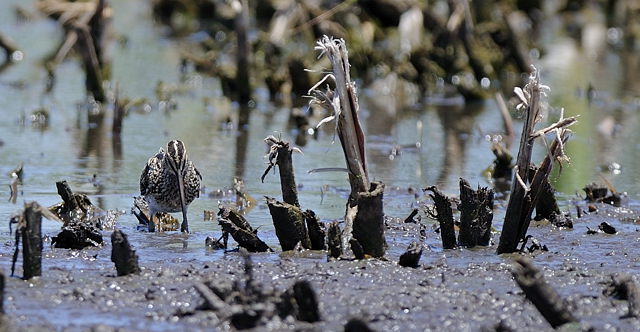 © Dewi
© Dewi
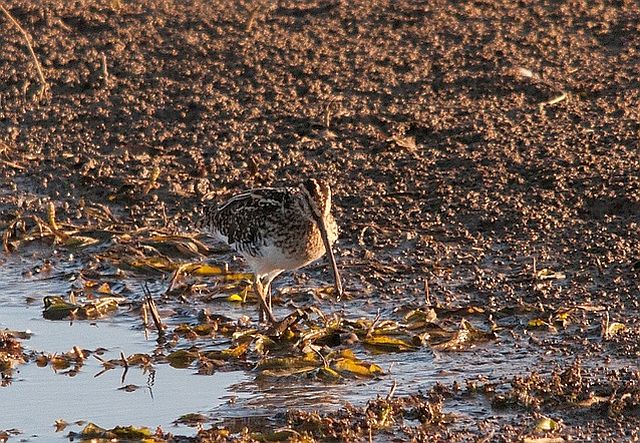 © Joan
© Joan
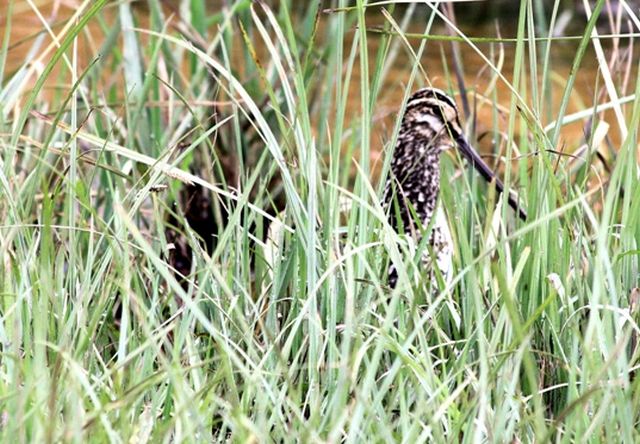 © Amoli
© Amoli
Rietvlei Nature Reserve, Gauteng
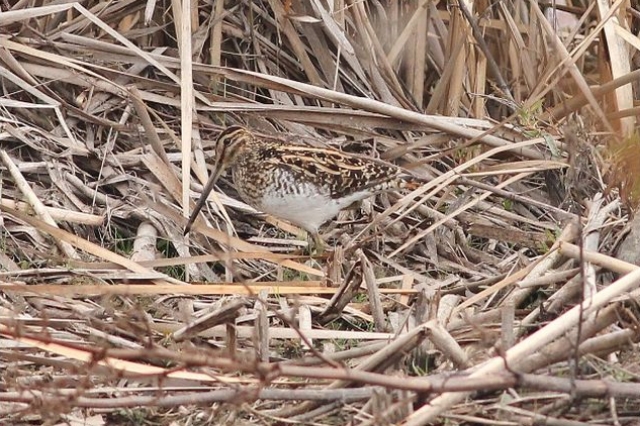 © Amoli
© Amoli
Marievale, Gauteng
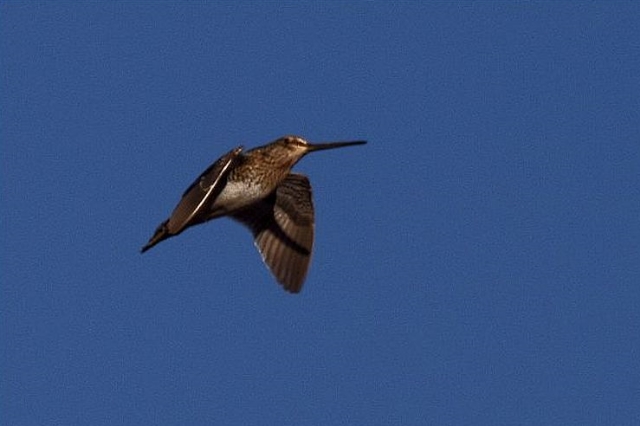 © Duke
© Duke
Marievale, Gauteng
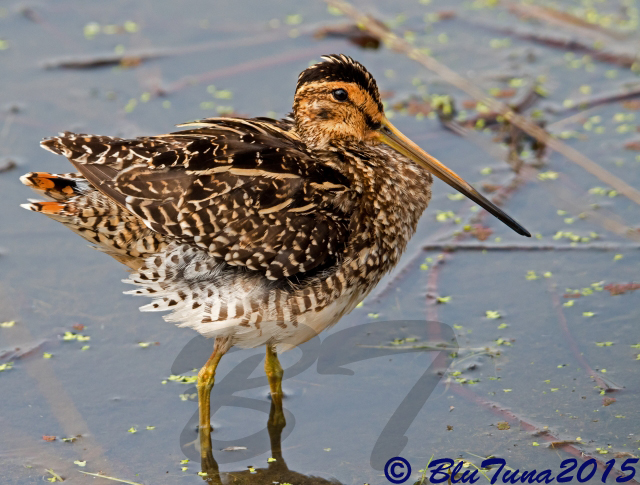 © BluTuna
© BluTuna
Marievale, Gauteng
Links:
Sabap2
Fitzpatrick Institut: The secret life of Snipes
Sasol Bird e-Guide
 © Dewi
© Dewi © Joan
© Joan © Amoli
© AmoliRietvlei Nature Reserve, Gauteng
 © Amoli
© AmoliMarievale, Gauteng
 © Duke
© DukeMarievale, Gauteng
 © BluTuna
© BluTunaMarievale, Gauteng
Links:
Sabap2
Fitzpatrick Institut: The secret life of Snipes
Sasol Bird e-Guide
Kgalagadi lover… for ever
https://safrounet.piwigo.com/
https://safrounet.piwigo.com/
Black-tailed Godwit
287. Black-tailed Godwit Limosa limosa (Swartstertgriet)
Order: Charadriiformes. Family: Scolopacidae
Description
Straight, flesh-coloured bill with dark tip. Greyish legs.
In breeding plumage, wings strikingly black & white with brick red head, neck and breast extending to the belly. Brown, streaked black, upperparts. White wing-bar and dark wing tips. The white tail has a black bar at the tip. Belly white, marked with black. During the breeding season, the bill has a yellowish or orange-pink base and dark tip.
In non-breeding, greyer on head, neck and breast with uniform brown-grey breast and upperparts. The pink parts become greyish, upperparts greyer and the belly loses the streaks.
Juveniles have a pale orange wash to the neck and breast.
Distribution
Breeds in patches from Iceland south to France and east to Manchuria and Siberia, heading south in the non-breeding season to eastern Australia to sub-Saharan Africa (especially within 30° of the equator). Winters in India, Australia, Western Europe and West Africa. It is a rare non-breeding migrant to southern Africa, with several dozen records spread across the region (largely excluding Mozambique).
Within Africa, the nonbreeding range is mainly the Sahelian zone from Senegal to the Sudan. Birds viewed critically in southern Africa are mostly immatures; adults presumably remain further north in Africa.
Habitat: Occurs in wide variety of habitats, generally preferring lake margins, marshes, swamps, irrigated lands with soft substratum and coastal wetlands. In southern Africa, the Blacktailed Godwit is usually seen on wetlands in the interior.
Movements and migrations
Arrives in its West African non-breeding grounds in July, arriving a few months later in East Africa and staying until about April. Most southern African records are in the period from December-April; most birds which reach the region are thought to originate from East Africa.
Diet
Invertebrates. It eats molluscs, polychaete worms, plant material and fly larvae, doing most of its foraging in deeper water (5-10 cm) than other waders, pecking the soft mud before probing deeply once it has located prey.
Breeding
Black-tailed Godwits are mostly monogamous. The nest is built on the ground, and three or four eggs are produced. These are incubated for up to 24 days, and the young godwits will have fledged after a further 20 days.
Call
Flight call wicka, wicka, wicka. Listen to Bird Call.
Status
Rare Summer visitor.
Order: Charadriiformes. Family: Scolopacidae
Description
Straight, flesh-coloured bill with dark tip. Greyish legs.
In breeding plumage, wings strikingly black & white with brick red head, neck and breast extending to the belly. Brown, streaked black, upperparts. White wing-bar and dark wing tips. The white tail has a black bar at the tip. Belly white, marked with black. During the breeding season, the bill has a yellowish or orange-pink base and dark tip.
In non-breeding, greyer on head, neck and breast with uniform brown-grey breast and upperparts. The pink parts become greyish, upperparts greyer and the belly loses the streaks.
Juveniles have a pale orange wash to the neck and breast.
Distribution
Breeds in patches from Iceland south to France and east to Manchuria and Siberia, heading south in the non-breeding season to eastern Australia to sub-Saharan Africa (especially within 30° of the equator). Winters in India, Australia, Western Europe and West Africa. It is a rare non-breeding migrant to southern Africa, with several dozen records spread across the region (largely excluding Mozambique).
Within Africa, the nonbreeding range is mainly the Sahelian zone from Senegal to the Sudan. Birds viewed critically in southern Africa are mostly immatures; adults presumably remain further north in Africa.
Habitat: Occurs in wide variety of habitats, generally preferring lake margins, marshes, swamps, irrigated lands with soft substratum and coastal wetlands. In southern Africa, the Blacktailed Godwit is usually seen on wetlands in the interior.
Movements and migrations
Arrives in its West African non-breeding grounds in July, arriving a few months later in East Africa and staying until about April. Most southern African records are in the period from December-April; most birds which reach the region are thought to originate from East Africa.
Diet
Invertebrates. It eats molluscs, polychaete worms, plant material and fly larvae, doing most of its foraging in deeper water (5-10 cm) than other waders, pecking the soft mud before probing deeply once it has located prey.
Breeding
Black-tailed Godwits are mostly monogamous. The nest is built on the ground, and three or four eggs are produced. These are incubated for up to 24 days, and the young godwits will have fledged after a further 20 days.
Call
Flight call wicka, wicka, wicka. Listen to Bird Call.
Status
Rare Summer visitor.
Dewi
What is the good of having a nice house without a decent planet to put it on? (H D Thoreau)
What is the good of having a nice house without a decent planet to put it on? (H D Thoreau)
Black-tailed Godwit Photos
287. Black-tailed Godwit Limosa limosa
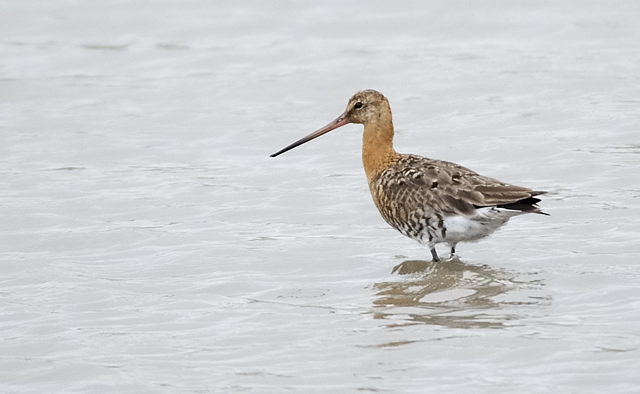
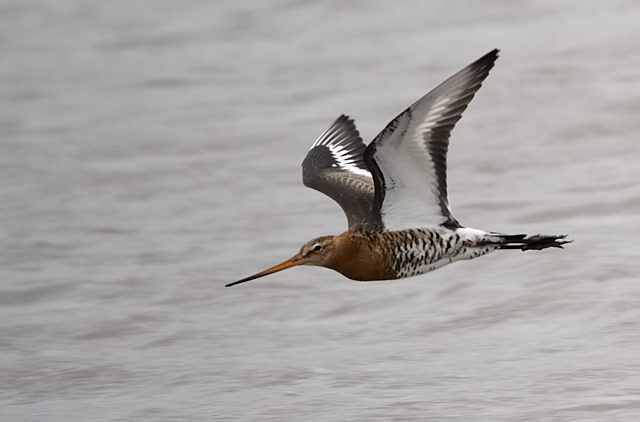
Links:
Sabap2: http://sabap2.adu.org.za/spp_summary.ph ... §ion=3
Birds of Botswana
Mark Beaman, Steve Madge. The Handbook of Bird Identification: For Europe and the Western Palearctic
Bill Oddie's Birds of Britain and Ireland
Hockey, P.A.R. 1998. Africa’s waders: a guide to their identification. Part 2. Africa - Birds & Birding 3(2):63-69.


Links:
Sabap2: http://sabap2.adu.org.za/spp_summary.ph ... §ion=3
Birds of Botswana
Mark Beaman, Steve Madge. The Handbook of Bird Identification: For Europe and the Western Palearctic
Bill Oddie's Birds of Britain and Ireland
Hockey, P.A.R. 1998. Africa’s waders: a guide to their identification. Part 2. Africa - Birds & Birding 3(2):63-69.
Dewi
What is the good of having a nice house without a decent planet to put it on? (H D Thoreau)
What is the good of having a nice house without a decent planet to put it on? (H D Thoreau)
Bar-tailed Godwit
288. Bar-tailed Godwit Limosa lapponica (Bandstertgriet)
Order: Charadriiformes. Family: Scolopacidae
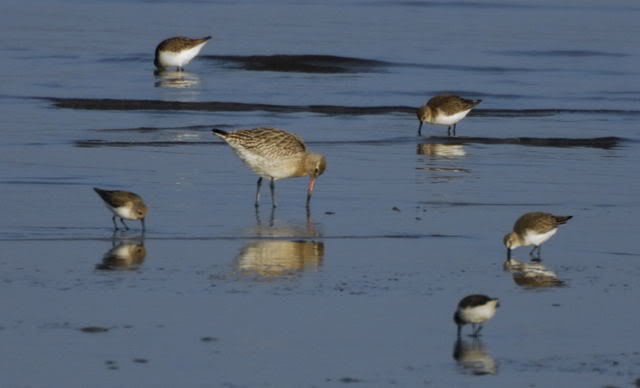
Description
The Bar-tailed Godwit is a relatively short-legged species of godwit. The bill-to-tail length is 37–41 cm, with a wingspan of 70–80 cm.
The adult has blue-grey legs and a very long dark bill with a slight upward curve and pink at the tip. The neck, breast and belly are unbroken brick red in breeding plumage, off white in winter. Greyish brown upperpart, head, neck and breast. Barred tail pattern.
Non-breeding plumage is mottled gray-brown overall.
Similar species: At rest this species resembles the slightly larger Black-tailed Godwit, but its upcurved bill is shorter and is distinguished by its barred, rather than wholly black, tail and a lack of white wing bars. In flight it lacks Black-tailed Godwit's white wing bar and has thinly brown-barred, not broadly black-tipped tail.
Distribution
Breeds in the Arctic and makes the longest non-stop migration of any bird. Winters in temperate and tropical regions of the Old World. Found on all coasts throughout the sub-region in Summer months.
The Bartailed Godwit has a fragmented breeding distribution from Finnmark across Siberia to Alaska. The latitudinal breeding range is narrow, confined to typical tundra, shrub-tundra and foresttundra. In the nonbreeding season, the nominate race occurs along coasts from Denmark to southern Africa, the
Arabian Peninsula to Bombay.
It is a coastal wader in southern Africa; there are two concentrations: in northern Namibia, Kunene River to Sandwich Harbour, and in the southwestern Cape Province, Olifants River mouth to Cape Point. The estimated population for southern Africa is 2600 birds.
Taxonomy
There are three subspecies:
Limosa lapponica lapponica breeds from northern Scandinavia east to the Taymyr Peninsula; winters western coasts of Europe and Africa from the British Isles and the Netherlands south to South Africa, and also around the Persian Gulf. Smallest subspecies, males up to 360 g, females to 450 g.
Limosa lapponica menzbieri breeds northeastern Asia from the Taymyr Peninsula east to the Kolyma River delta; winters southeastern Asia and Australia. Intermediate between the other two subspecies.
Limosa lapponica baueri breeds far northeastern Asia east of the Kolyma River, and western Alaska; winters in Australia and New Zealand. Largest subspecies.
Habitat
Estuaries, coastal lagoons and mudflats. It occurs mainly at sheltered inlets, e.g. Walvis Bay Lagoon, Sandwich Harbour, Langebaan Lagoon, and estuaries with large expanses of intertidal sand or mud, e.g. Berg River and Swartkops River. On sheltered coastlines in central Namibia and the southwestern Cape Province, it sometimes feeds at washed-up kelp.
Movements and migrations
A non-breeding migrant, probably undertaking the longest non-stop journey of any terrestrial bird, as one subspecies travels 11 600 km from Alaska to New Zealand. It starts arriving in southern Africa in October, with numbers peaking in November before departing in March and April.
Diet
Insects & crustaceans. It mainly eats polychaete worms, molluscs, crustaceans and fish fry, doing most of its foraging in flocks, walking through mud or shallow water, probing with its long bill in search of prey.
Breeding
Breeding take place each year in Scandinavia, northern Asia, and Alaska. The nest is a shallow cup in moss sometimes lined with vegetation. Both sexes share incubation of the eggs and care for the young.
Call
Flight call harsh kirruk. Listen to Bird Call.
Status
Reasonably common summer visitor.
Order: Charadriiformes. Family: Scolopacidae

Description
The Bar-tailed Godwit is a relatively short-legged species of godwit. The bill-to-tail length is 37–41 cm, with a wingspan of 70–80 cm.
The adult has blue-grey legs and a very long dark bill with a slight upward curve and pink at the tip. The neck, breast and belly are unbroken brick red in breeding plumage, off white in winter. Greyish brown upperpart, head, neck and breast. Barred tail pattern.
Non-breeding plumage is mottled gray-brown overall.
Similar species: At rest this species resembles the slightly larger Black-tailed Godwit, but its upcurved bill is shorter and is distinguished by its barred, rather than wholly black, tail and a lack of white wing bars. In flight it lacks Black-tailed Godwit's white wing bar and has thinly brown-barred, not broadly black-tipped tail.
Distribution
Breeds in the Arctic and makes the longest non-stop migration of any bird. Winters in temperate and tropical regions of the Old World. Found on all coasts throughout the sub-region in Summer months.
The Bartailed Godwit has a fragmented breeding distribution from Finnmark across Siberia to Alaska. The latitudinal breeding range is narrow, confined to typical tundra, shrub-tundra and foresttundra. In the nonbreeding season, the nominate race occurs along coasts from Denmark to southern Africa, the
Arabian Peninsula to Bombay.
It is a coastal wader in southern Africa; there are two concentrations: in northern Namibia, Kunene River to Sandwich Harbour, and in the southwestern Cape Province, Olifants River mouth to Cape Point. The estimated population for southern Africa is 2600 birds.
Taxonomy
There are three subspecies:
Limosa lapponica lapponica breeds from northern Scandinavia east to the Taymyr Peninsula; winters western coasts of Europe and Africa from the British Isles and the Netherlands south to South Africa, and also around the Persian Gulf. Smallest subspecies, males up to 360 g, females to 450 g.
Limosa lapponica menzbieri breeds northeastern Asia from the Taymyr Peninsula east to the Kolyma River delta; winters southeastern Asia and Australia. Intermediate between the other two subspecies.
Limosa lapponica baueri breeds far northeastern Asia east of the Kolyma River, and western Alaska; winters in Australia and New Zealand. Largest subspecies.
Habitat
Estuaries, coastal lagoons and mudflats. It occurs mainly at sheltered inlets, e.g. Walvis Bay Lagoon, Sandwich Harbour, Langebaan Lagoon, and estuaries with large expanses of intertidal sand or mud, e.g. Berg River and Swartkops River. On sheltered coastlines in central Namibia and the southwestern Cape Province, it sometimes feeds at washed-up kelp.
Movements and migrations
A non-breeding migrant, probably undertaking the longest non-stop journey of any terrestrial bird, as one subspecies travels 11 600 km from Alaska to New Zealand. It starts arriving in southern Africa in October, with numbers peaking in November before departing in March and April.
Diet
Insects & crustaceans. It mainly eats polychaete worms, molluscs, crustaceans and fish fry, doing most of its foraging in flocks, walking through mud or shallow water, probing with its long bill in search of prey.
Breeding
Breeding take place each year in Scandinavia, northern Asia, and Alaska. The nest is a shallow cup in moss sometimes lined with vegetation. Both sexes share incubation of the eggs and care for the young.
Call
Flight call harsh kirruk. Listen to Bird Call.
Status
Reasonably common summer visitor.
Last edited by nan on Sat Jan 05, 2013 3:56 pm, edited 1 time in total.
Dewi
What is the good of having a nice house without a decent planet to put it on? (H D Thoreau)
What is the good of having a nice house without a decent planet to put it on? (H D Thoreau)
Bar-tailed Godwit Photos
288. Bar-tailed Godwit Limosa lapponica (Bandstertgriet)
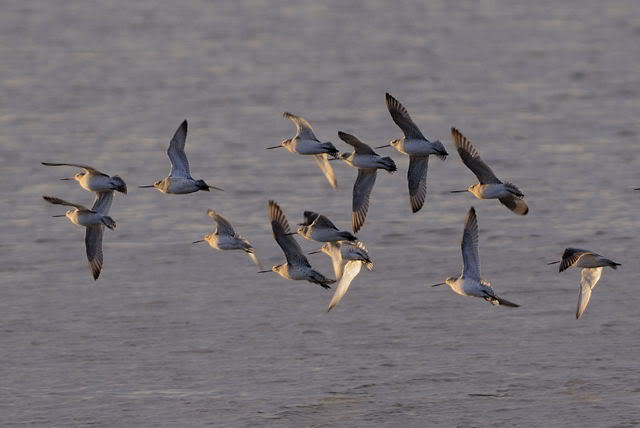
Links:
Sabap2: http://sabap2.adu.org.za/spp_summary.ph ... §ion=3
Birds of Botswana
Oiseaux net: http://www.oiseaux-birds.com/card-bar-t ... odwit.html
ARKive: http://www.arkive.org/bar-tailed-godwit ... lapponica/
Mark Beaman, Steve Madge.The Handbook of Bird Identification: For Europe and the Western Palearctic
Bill Oddie's Birds of Britain and Ireland
Hockey, P.A.R. 1998. Africa’s waders: a guide to their identification. Part 2. Africa - Birds & Birding 3(2):63-69.

Links:
Sabap2: http://sabap2.adu.org.za/spp_summary.ph ... §ion=3
Birds of Botswana
Oiseaux net: http://www.oiseaux-birds.com/card-bar-t ... odwit.html
ARKive: http://www.arkive.org/bar-tailed-godwit ... lapponica/
Mark Beaman, Steve Madge.The Handbook of Bird Identification: For Europe and the Western Palearctic
Bill Oddie's Birds of Britain and Ireland
Hockey, P.A.R. 1998. Africa’s waders: a guide to their identification. Part 2. Africa - Birds & Birding 3(2):63-69.
Last edited by Mel on Sun Jan 06, 2013 8:41 am, edited 1 time in total.
Dewi
What is the good of having a nice house without a decent planet to put it on? (H D Thoreau)
What is the good of having a nice house without a decent planet to put it on? (H D Thoreau)
Eurasian Whimbrel
290. Eurasian Whimbrel Numenius phaeopus (Kleinwulp)
Order: Charadriiformes. Family: Scolopacidae
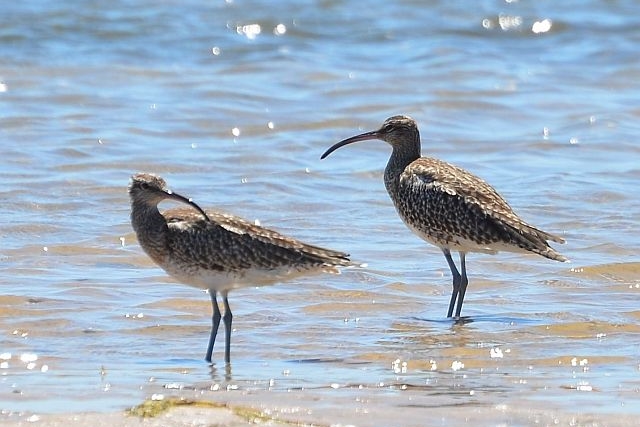 © Grumpy
© Grumpy
Taxonomic Note:
Name change from Whimbrel to Eurasian Whimbrel follows split of Hudsonian Whimbrel.
Description
Length 37-45 cm (incl. bill 6-9 cm), wingspan 78-88 cm. The body of this bird is patterned in brownish to brownish-grey colours, especially on the underside over a lighter basis. The bill is bent down about 1/3 from the tip. On the side of the head is a dark stripe through the eye, a light supercilium, a dark stripe above that one, and a light central stripe. The three crown stripes are the most conspicous of these if the crown can be seen well. The long, decurved bill is black, the legs are yellow and the eyes are brown. The sexes are alike in plumage, but the females are larger than the males and have a longer bill.
Immature is similar to adult, but back with light spots, crown stripe less distinct, breast more buff, and with finer streaking on neck and chest.
Similar species: Apart from Eurasian Curlew, this is the only large wader in the region with a decurved bill. The bill is shorter and less evenly curved than in the Eurasian Curlew.
Distribution
Breeds in the circumpolar region above 55° North, heading south in the non-breeding season to the coastline of continents and most islands south of 35° North (especially common in the tropics), including southern Africa. Here it is common along the entire coastline of the region, while it is a vagrant further inland.
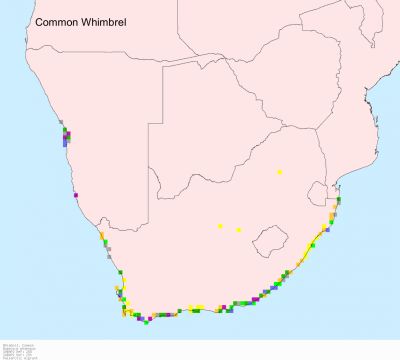
Habitat
Coastal lagoons and estuaries, especially with sand and rocky intertidal habitats, mangroves or salt-marshes.
Movements and migrations
Most southern African birds probably originate from eastern Russia and Siberia, arriving in the region from August-October and staying until about late March and April. It eventually gets back to its breeding breed grounds in the period from May-June.
Diet: It mainly eats crustaceans, molluscs and annelids, doing most of its foraging at night, probing and pecking the ground in search of prey.
A Long Beak for the Non-breeding Habitat
Many birds undertake seasonal migrations. In some cases, these journeys take them from one habitat to another and from one diet to another. In instances such as this, an evolutionary ‘decision’ needs to be taken as regards beak structure: should it be well adapted for a certain time of year or should it be a compromise that works adequately in all seasons, but perhaps not brilliantly in any one?
Numenius phaeopus breeds on boreal moorland and tundra fringes, where it eats mostly the abundant terrestrial arthropods, the majority of which are caught at or very close to the soil surface. The elaborate curved beak seems of little obvious value in this situation – a much shorter
beak would have been adequate. Yet if prey on the breeding grounds are easily caught, then the long beak may not be a significant handicap. During the nonbreeding season, however, these birds move to coastal mud- and sand-flats where many of their prey, particularly prawns and worms, are quite deeply buried (and prawns live in curved burrows). Here, where there are many potential competitors for surface-dwelling or shallowly buried prey, the long, curved beak comes into its own. This suggests that, in the case of whimbrels, it is conditions on the non-breeding grounds that have provided the selective force favouring the long beak.
Breeding
Whimbrel are ground nesters, making a shallow nest appox 18cm in diameter and up to 6 cm high, this is lined with vegetation. The eggs are olive to buff with dark brown spots and blotches, a clutch is usually 3 to 4 eggs. Both male and female incubate the eggs for up to 28 days, hatching is synchronous as incubation only starts after the last egg is laid. The young are nidifugous and self feeding, they fledge within 40 days and are completely independent very soon after fledging.
Call
The call of the Eurasian Whimbrel, most commonly given while the bird is in flight, is a loudly uttered upupupupu that can be heard from quite a distance.
Listen to Bird Call.
Status
A common summer visitor.
Order: Charadriiformes. Family: Scolopacidae
 © Grumpy
© GrumpyTaxonomic Note:
Name change from Whimbrel to Eurasian Whimbrel follows split of Hudsonian Whimbrel.
Description
Length 37-45 cm (incl. bill 6-9 cm), wingspan 78-88 cm. The body of this bird is patterned in brownish to brownish-grey colours, especially on the underside over a lighter basis. The bill is bent down about 1/3 from the tip. On the side of the head is a dark stripe through the eye, a light supercilium, a dark stripe above that one, and a light central stripe. The three crown stripes are the most conspicous of these if the crown can be seen well. The long, decurved bill is black, the legs are yellow and the eyes are brown. The sexes are alike in plumage, but the females are larger than the males and have a longer bill.
Immature is similar to adult, but back with light spots, crown stripe less distinct, breast more buff, and with finer streaking on neck and chest.
Similar species: Apart from Eurasian Curlew, this is the only large wader in the region with a decurved bill. The bill is shorter and less evenly curved than in the Eurasian Curlew.
Distribution
Breeds in the circumpolar region above 55° North, heading south in the non-breeding season to the coastline of continents and most islands south of 35° North (especially common in the tropics), including southern Africa. Here it is common along the entire coastline of the region, while it is a vagrant further inland.

Habitat
Coastal lagoons and estuaries, especially with sand and rocky intertidal habitats, mangroves or salt-marshes.
Movements and migrations
Most southern African birds probably originate from eastern Russia and Siberia, arriving in the region from August-October and staying until about late March and April. It eventually gets back to its breeding breed grounds in the period from May-June.
Diet: It mainly eats crustaceans, molluscs and annelids, doing most of its foraging at night, probing and pecking the ground in search of prey.
A Long Beak for the Non-breeding Habitat
Many birds undertake seasonal migrations. In some cases, these journeys take them from one habitat to another and from one diet to another. In instances such as this, an evolutionary ‘decision’ needs to be taken as regards beak structure: should it be well adapted for a certain time of year or should it be a compromise that works adequately in all seasons, but perhaps not brilliantly in any one?
Numenius phaeopus breeds on boreal moorland and tundra fringes, where it eats mostly the abundant terrestrial arthropods, the majority of which are caught at or very close to the soil surface. The elaborate curved beak seems of little obvious value in this situation – a much shorter
beak would have been adequate. Yet if prey on the breeding grounds are easily caught, then the long beak may not be a significant handicap. During the nonbreeding season, however, these birds move to coastal mud- and sand-flats where many of their prey, particularly prawns and worms, are quite deeply buried (and prawns live in curved burrows). Here, where there are many potential competitors for surface-dwelling or shallowly buried prey, the long, curved beak comes into its own. This suggests that, in the case of whimbrels, it is conditions on the non-breeding grounds that have provided the selective force favouring the long beak.
Breeding
Whimbrel are ground nesters, making a shallow nest appox 18cm in diameter and up to 6 cm high, this is lined with vegetation. The eggs are olive to buff with dark brown spots and blotches, a clutch is usually 3 to 4 eggs. Both male and female incubate the eggs for up to 28 days, hatching is synchronous as incubation only starts after the last egg is laid. The young are nidifugous and self feeding, they fledge within 40 days and are completely independent very soon after fledging.
Call
The call of the Eurasian Whimbrel, most commonly given while the bird is in flight, is a loudly uttered upupupupu that can be heard from quite a distance.
Listen to Bird Call.
Status
A common summer visitor.
Eurasian Whimbrel Photos
290. Eurasian Whimbrel Numenius phaeopus
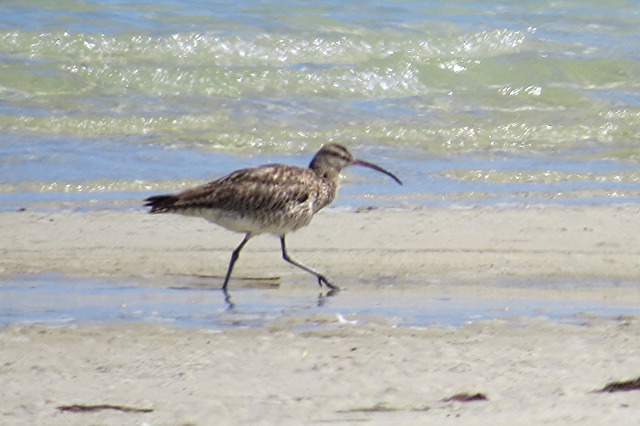 © Tina
© Tina
West Coast National Park
 © Dindingwe
© Dindingwe
Macaneta Wetlands, about 30 kms north of Maputo
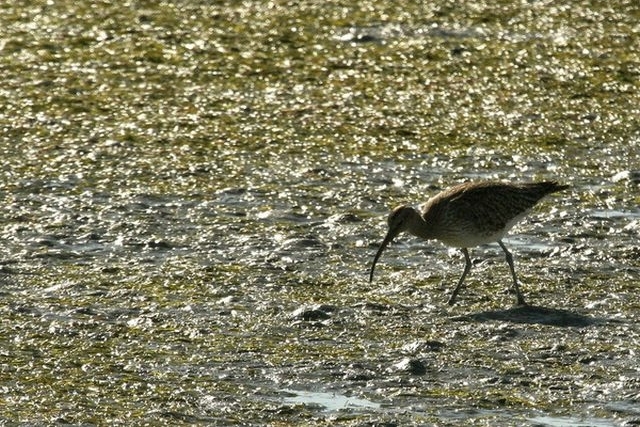 © nan
© nan
West Coast National Park
 © Peter Connan
© Peter Connan
Maphelane, iSimangaliso Wetland Park, KwaZulu-Natal
Links:
Species text in The Atlas of Southern African Birds: http://sabap2.adu.org.za/docs/sabap1/290.pdf
Sabap2: http://sabap2.adu.org.za/species_info.p ... #menu_left
Birds of Botswana
Oiseaux net
Hockey, P.A.R. 1998. Africa’s waders: a guide to their identification. Part 2. Africa - Birds & Birding 3(2):63-69.
 © Tina
© TinaWest Coast National Park
Macaneta Wetlands, about 30 kms north of Maputo
 © nan
© nanWest Coast National Park
 © Peter Connan
© Peter ConnanMaphelane, iSimangaliso Wetland Park, KwaZulu-Natal
Links:
Species text in The Atlas of Southern African Birds: http://sabap2.adu.org.za/docs/sabap1/290.pdf
Sabap2: http://sabap2.adu.org.za/species_info.p ... #menu_left
Birds of Botswana
Oiseaux net
Hockey, P.A.R. 1998. Africa’s waders: a guide to their identification. Part 2. Africa - Birds & Birding 3(2):63-69.



